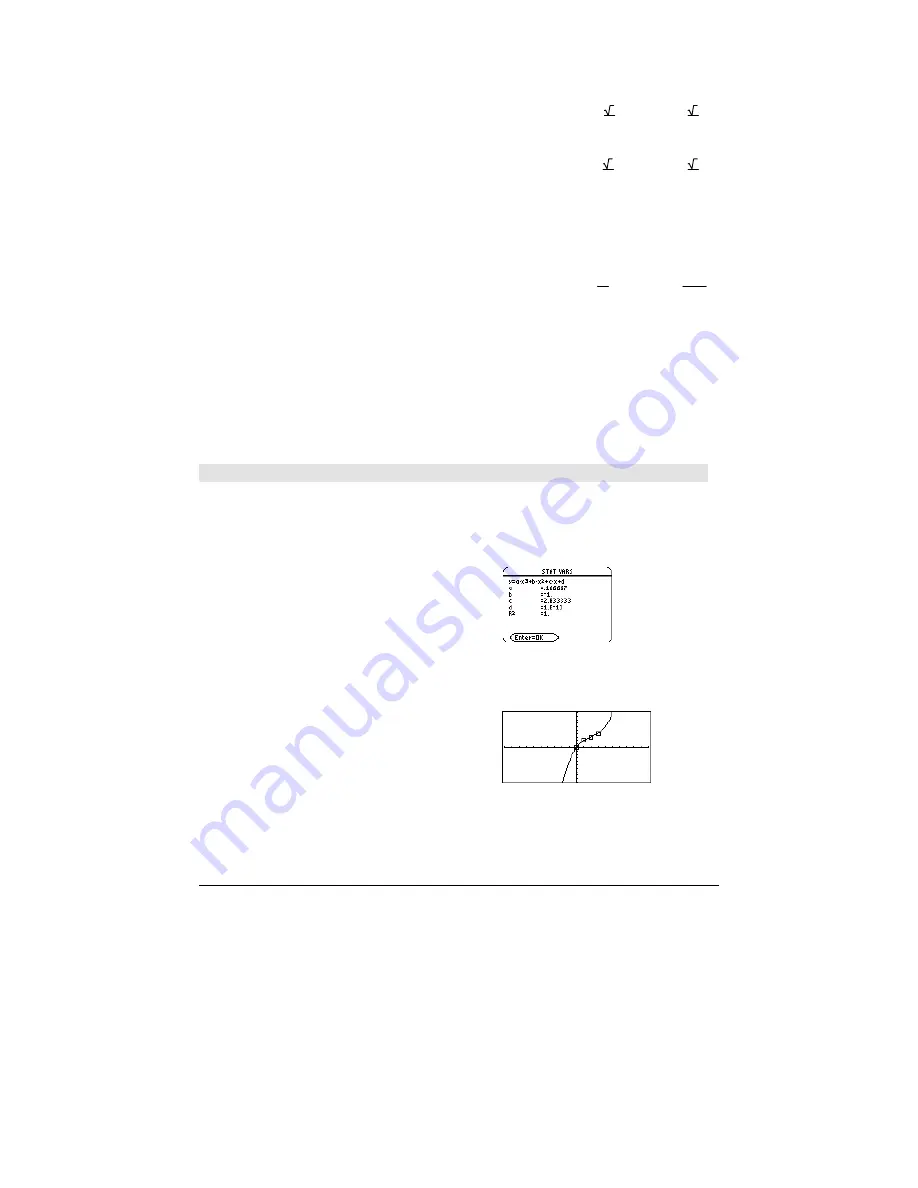
800
Appendix A: Functions and Instructions
You can also include solution variables that do
not appear in the equations. These solutions
show how families of solutions might contain
arbitrary constants of the form @
k
, where
k
is an
integer suffix from 1 through 255. The suffix
resets to 1 when you use
ClrHome
or
ƒ
8:Clear Home
.
For polynomial systems, computation time or
memory exhaustion may depend strongly on the
order in which you list solution variables. If your
initial choice exhausts memory or your patience,
try rearranging the variables in the equations
and/or
varOrGuess
list.
cSolve(u_
ù
v_
ì
u_=v_ and
v_^2=
ë
u_,{u_,v_,w_})
¸
u_=1/2
+
3
2
ø
i
and v_=1/2
ì
3
2
ø
i
and
w_=@1
or
u_=1/2
ì
3
2
ø
i
and v_=1/2 +
3
2
ø
i
and
w_=@1
or u_=0 and v_=0 and w_=@1
If you do not include any guesses and if any
equation is non-polynomial in any variable but all
equations are linear in all solution variables,
cSolve()
uses Gaussian elimination to attempt to
determine all solutions.
cSolve(u_+v_=
e
^(w_) and u_
ì
v_=
i
, {u_,v_})
¸
u_=
e
w_
2
+1/2
ø
i
and v_=
e
w_
ì
i
2
If a system is neither polynomial in all of its
variables nor linear in its solution variables,
cSolve()
determines at most one solution using
an approximate iterative method. To do so, the
number of solution variables must equal the
number of equations, and all other variables in
the equations must simplify to numbers.
cSolve(
e
^(z_)=w_ and w_=z_^2, {w_,z_})
¸
w_=.494… and z_=
ë
.703…
A non-real guess is often necessary to determine
a non-real solution. For convergence, a guess
might have to be rather close to a solution.
cSolve(
e
^(z_)=w_ and w_=z_^2, {w_,z_=1+
i
})
¸
w_=.149… + 4.891…
ø
i
and
z_=1.588… + 1.540…
ø
i
CubicReg
MATH/Statistics/Regressions menu
CubicReg
list1
,
list2
[
,
[
list3
] [
,
list4
,
list5
]
]
Calculates the cubic polynomial regression and
updates all the statistics variables.
All the lists must have equal dimensions except
for
list5
.
list1
represents xlist.
list2
represents ylist.
list3
represents frequency.
list4
represents category codes.
list5
represents category include list.
Note:
list1
through
list4
must be a variable name
or c1–c99 (columns in the last data variable
shown in the Data/Matrix Editor).
list5
does not
have to be a variable name and cannot be c1–c99
.
In function graphing mode.
{0,1,2,3}
!
L1
¸
{0 1 2 3}
{0,2,3,4}
!
L2
¸
{0 2 3 4}
CubicReg L1,L2
¸
Done
ShowStat
¸
¸
regeq(x)
"
y1(x)
¸
Done
NewPlot 1,1,L1,L2
¸
Done
¥ %
Summary of Contents for Voyage 200
Page 36: ...Getting Started 36 D B D B Press Result ...
Page 45: ...Getting Started 45 3 0 D B D D B D Press Result ...
Page 46: ...Getting Started 46 D 2 0 0 2 D B Scroll down to October and press Press Result ...
Page 60: ...Getting Started 60 B D Press Result ...
Page 139: ...Previews 139 8 Complete the operation Press 2 d Steps and keystrokes Display 5 f 2 ...
Page 453: ...Differential Equation Graphing 453 ...
Page 468: ...Tables 468 ...
Page 777: ...Activities 777 ...
















































